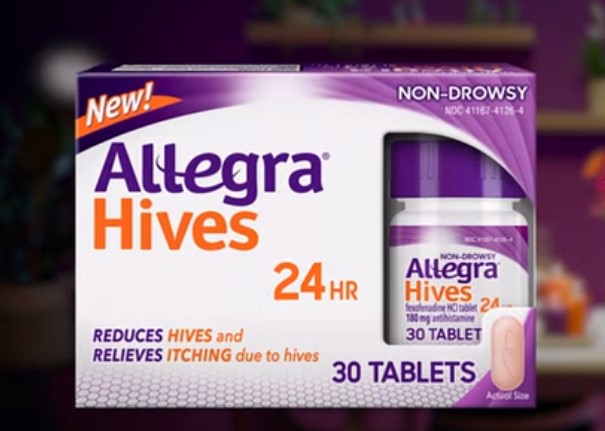Allergies can be a persistent and uncomfortable issue for many, leading to a search for effective relief. Among the various options available, Allegra and its variant specifically designed for hives, known as Allegra Hives, stand out.
While both medications are rooted in the same family, understanding their distinct characteristics is crucial for those seeking targeted treatment. In the following sections, we will explore each medication in detail, examining their composition, mechanism of action, and intended uses.
What is Allegra?

Allegra, scientifically known as Fexofenadine, is an over-the-counter medication that falls under the category of second-generation antihistamines. Unlike its first-generation counterparts, it is known for causing less drowsiness, making it a preferred choice for individuals seeking relief without significant sedation. It is widely used to alleviate symptoms such as sneezing, runny nose, itchy or watery eyes, and other common manifestations of allergic reactions.
Common Uses
The primary application of this medication is in the treatment of seasonal allergies, often referred to as hay fever. These allergies are typically triggered by pollen from various plants and can cause considerable discomfort.
Additionally, it is effective in managing symptoms associated with chronic urticaria, which presents as itchy skin rashes or hives. Its ability to reduce histamine levels in the body, which are responsible for allergy symptoms, makes it a go-to solution for many.
According to Forbes Health:
“Allegra Allergy products can help relieve allergy symptoms that stem from both indoor and outdoor allergies, including congestion, runny nose, itchy nose and throat, sneezing and watery eyes.”
Active Ingredients
The active ingredient is Fexofenadine hydrochloride. This compound works by inhibiting the action of histamine, a chemical released during an allergic reaction that contributes to symptom development. By blocking histamine receptors, it prevents the onset of allergic symptoms, providing relief to the user. It’s important to note that while effective, it does not prevent the actual allergic reaction but rather mitigates its symptoms.
How it Works?

Allegra operates by selectively targeting histamine H1 receptors, which are primarily responsible for mediating allergic responses. Its selective action ensures that it does not readily cross the blood-brain barrier, thus minimizing the risk of drowsiness, a common side effect associated with older antihistamines.
This specificity allows for effective symptom relief while maintaining alertness and cognitive function. There is also a chance for certain antihistamines to cause one type of allergy while treating another one.
Duration of Effectiveness
One of the key advantages is its long-lasting effect. Typically, the relief provided can last for up to 24 hours, making it a convenient option for daily use. This extended duration means that individuals can manage their allergy symptoms with a single daily dose, simplifying their medication regimen and improving adherence.
Usage and Dosage
The standard dosage for adults and children over 12 years is 60 mg twice daily or 180 mg once daily. It is recommended to take this medication with water and on an empty stomach for optimal absorption. However, it’s crucial to follow the specific dosage instructions provided by a healthcare professional or as indicated on the product label.
Precautions and Contraindications
While it is generally safe for most individuals, certain precautions should be taken. It’s advisable to consult with a healthcare provider before starting the medication, especially for those with pre-existing health conditions or those taking other medications.
Pregnant or breastfeeding women should also seek medical advice prior to use. Additionally, while rare, some individuals may experience side effects, and any unusual reactions should be promptly reported to a healthcare professional.
How is Allegra Hives Different?

Allegra Hives is a variant of the standard medication, formulated to specifically target and alleviate the symptoms of hives. Chronic idiopathic urticaria is a condition where hives appear without a known cause and persist for an extended period. Hives, with its antihistamine properties, is designed to reduce the severity and frequency of these outbreaks, providing much-needed relief to sufferers.
Targeted Use
The primary focus is the treatment of skin-related allergic reactions, particularly chronic hives. Unlike seasonal allergies, hives can occur without external allergens like pollen. They often manifest as a reaction to internal factors, making their treatment more complex. Allegra Hives works to alleviate the itching and discomfort associated with hives, improving the quality of life for those affected by this condition.
Active Ingredients
Similar to the standard one, the active ingredient in this one is Fexofenadine hydrochloride. However, the formulation and dosage may differ to cater specifically to the needs of individuals dealing with chronic urticaria. This targeted approach ensures that the medication effectively addresses the unique symptoms and challenges posed by hives.
How it Works?

The mechanism of action is similar to that of regular option, focusing on blocking histamine H1 receptors. However, its effect is particularly beneficial for skin-related allergic reactions. By reducing the histamine response, it diminishes the severity of hives, leading to less itching and discomfort. This targeted action makes it a preferred choice for those specifically battling chronic idiopathic urticaria.
Duration of Effectiveness
It offers sustained relief from hives, with its effects typically lasting for 24 hours. This extended duration is particularly beneficial for hives sufferers, as it provides consistent symptom management throughout the day and night. This continuous relief is crucial for improving sleep and daily functioning in individuals affected by chronic hives.
Usage and Dosage
The recommended dosage may vary based on the severity of the condition and the individual’s response to the medication. It is generally advised to follow the dosage instructions provided by a healthcare professional or as indicated on the product packaging. As with standard Allegra, it should be taken with water and preferably on an empty stomach.
Precautions and Contraindications
Individuals considering it should consult with a healthcare provider, especially if they have other medical conditions or are taking additional medications. Caution is advised for pregnant or breastfeeding women. While Allegra Hives is generally well-tolerated, any unusual reactions should be reported to a healthcare professional immediately.
Comparison

While both medications share a common foundation, their specific applications and characteristics cater to different needs.
Similarities Between the Two
Both of them contain the same active ingredient, Fexofenadine hydrochloride, which classifies them as second-generation antihistamines. This shared component ensures that both medications effectively reduce histamine-induced allergic symptoms with a lower risk of causing drowsiness compared to first-generation antihistamines. They are used in managing allergic reactions, providing relief from symptoms like itching, sneezing, and runny nose.
Key Differences
The primary distinction lies in their targeted applications. While Allegra is a general antihistamine used for a broad range of allergic reactions, including seasonal allergies and chronic urticaria, Allegra Hives is specifically formulated for the treatment of chronic idiopathic urticaria (hives). This specialization may influence the dosage and frequency of administration, making Allegra Hives more suited for individuals dealing exclusively with hives.
| Feature | Allegra | Allegra Hives |
|---|---|---|
| Primary Use | Broad allergy relief (seasonal allergies, chronic urticaria) | Specifically for chronic idiopathic urticaria (hives) |
| Active Ingredient | Fexofenadine hydrochloride | Fexofenadine hydrochloride |
| Target Audience | Individuals with various allergic conditions | Individuals specifically suffering from hives |
| Dosage Form | Standard dosage for general allergies | Potentially different dosage tailored for hives |
| Effectiveness Duration | Up to 24 hours | Up to 24 hours, with focus on hives relief |
| Sedation Risk | Low | Low |
| Specialization | General antihistamine | Specialized for hives treatment |
FAQs
Can Allegra or Allegra Hives be used in pediatric patients?
Allegra is approved for use in children as young as six years old for allergies and two years old for hives. However, Allegra Hives is typically recommended for adults and children over 12 years. It’s important to consult a pediatrician before administering either medication to children.
Are there any dietary restrictions while taking Allegra or Allegra Hives?
It’s recommended to avoid taking Allegra or Allegra Hives with fruit juices, such as orange, apple, or grapefruit juice, as they can decrease the absorption of the medication. Otherwise, there are no specific dietary restrictions, but it’s always wise to consult with a healthcare provider.
Can I take Allegra or Allegra Hives if I have a kidney condition?

Patients with kidney issues should consult their doctor before taking Allegra or Allegra Hives. Dosage adjustments may be necessary depending on the severity of the kidney condition.
Is it safe to drive or operate heavy machinery after taking Allegra or Allegra Hives?
Both Allegra and Allegra Hives are known to cause less drowsiness than first-generation antihistamines. However, it’s advisable to understand how your body reacts to these medications before engaging in activities like driving or operating heavy machinery.
Can Allegra or Allegra Hives be taken alongside other allergy medications?
Combining Allegra or Allegra Hives with other allergy medications, especially other antihistamines, can increase the risk of side effects. Always consult a healthcare provider before combining medications.
Are there any long-term side effects of using Allegra or Allegra Hives?
Both medications are generally considered safe for long-term use when taken as directed. However, if you have concerns or experience any unusual symptoms, it’s important to discuss these with your healthcare provider.
Conclusion
The choice between these two medications should be guided by the specific allergic condition one is facing. For general allergy symptoms, Allegra stands as a reliable option, while Allegra Hives is the go-to for those exclusively battling hives. It’s important to remember that while both offer substantial relief, consulting with a healthcare professional is crucial for personalized advice and optimal treatment.
